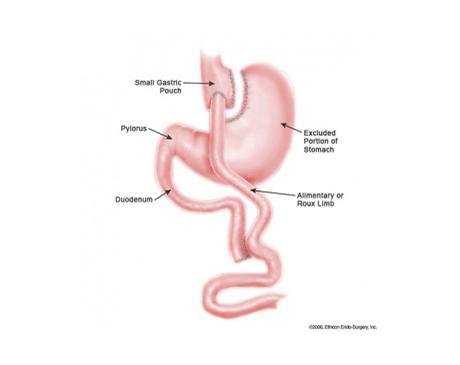Laparoscopic Roux-en-Y Gastric Bypass

Roux-en-Y gastric bypass (RYGB) is the most common and effective weight loss surgery, often called the gold standard. It combines restriction (creating a small stomach pouch) with malabsorption (bypassing part of the small intestine) to achieve significant, long-term weight loss and improvement in obesity-related conditions like diabetes and high blood pressure. The procedure can be performed either as an open surgery or more commonly as a minimally invasive laparoscopic surgery, which usually offers faster recovery.
How the Procedure Works & Lifestyle Commitment
During RYGB, a small pouch is created from the stomach and connected to a Y-shaped section of the small intestine, bypassing the duodenum and part of the jejunum. This limits food intake and reduces calorie absorption. Because of these changes, patients must make lifelong adjustments—eating smaller meals, prioritizing protein, taking vitamin supplements, and avoiding fatty or sugary foods. Long-term success depends on both the surgery and the patient’s commitment to healthy lifestyle choices.
In Roux-en-Y gastric bypass (RYGB), the stomach is reduced using surgical staples or vertical banding to form a small pouch that holds only a few ounces of food. A Y-shaped section of the small intestine is then attached to this pouch, bypassing the duodenum and jejunum, which reduces calorie and nutrient absorption.
Due to its restrictive and malabsorptive nature, RYGB requires lifelong dietary changes. Patients must eat smaller portions, prioritize protein, take vitamin supplements, and avoid sugary or fatty foods to maintain long-term success.
Pros and Cons of Roux-en-Y Gastric Bypass
Advantages of Roux-en-Y Gastric Bypass (RYGB):
- A reasonably low mortality rate (0.2% to 1%).
- Excellent weight loss when compared to Vertical Banded Gastroplasty (VBG).*
- Overall improved health.
- Resolution or elimination of co-morbidities (e.g., type II diabetes, sleep apnea, hypertension and more).
Disadvantages of Roux-en-Y Gastric Bypass (RYGB):
- Disruption of the staple line can lead to leakage or serious infection.
- Possible malnutrition or anemia.
- Possible obstruction of the GI tract.
- Risk of a hernia.
- Risk of chronic vomiting and diarrhea, or dumping syndrome.
- Various other post surgical complications.
Our Locations
Choose your preferred location
Contact with us!
We’re here to help — fill out the form to get in touch.
